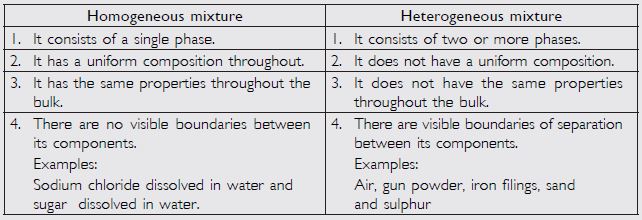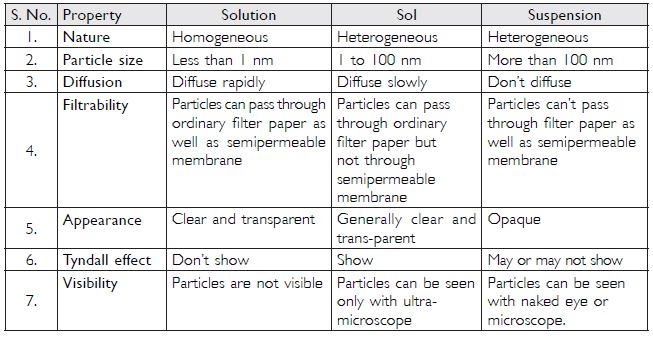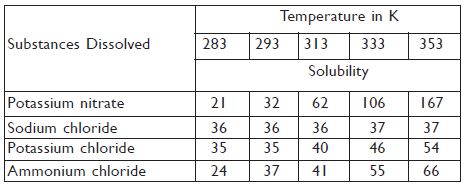Question 1:
What is meant by a pure substance?
Answer:
A material that is made up of only one type of particles and has a definite set of properties is called a pure substance. Pure substances include elements and compounds.
Question 2:
List the points of differences between homogeneous and heterogeneous mixtures.
Answer:
Question 3:
Differentiate between homogeneous and heterogeneous mixtures with examples.
Answer:
Refer questions 2, NCERT In-Text questions of page 15.
Question 4:
How are sol, solution and suspension different from each other?
Answer:
Question 5:
To make a saturated solution, 36 g of sodium chloride is dissolved in 100 g of water at 293 K. Find its concentration at this temperature.
Answer:
Mass of sodium chloride (solution) = 36 g
Mass of water (solvent) = 100 g
Total mass of solution = 100 + 36 = 136 g
Question 6:
How will you separate a mixture containing kerosene and petrol (difference in their boiling points is more than 25C), which are miscible with each other?
Answer:
By distillation
Question 7:
Name the technique to separate:
(i) Butter from curd
(ii) Salt from sea water
(iii) Camphor from salt
Answer:
(i) Centrifugation
(ii) Evaporation
(iii) Sublimation
Question 8:
What types of mixtures are separated by the technique of crystallisation?
Answer:
Crytallisation method is suitable for separating the mixtures in which:
(i) The desirable component is soluble in a suitable hot solvent and can be obtained as
crystals.
(ii) The other components are insoluble in the solvent.
Question 9:
Classify the following as chemical or physical changes:
(a) Cutting of trees
(b) Melting of butter in a pan
Answer:
(a) Cutting of trees — Physical change
(b) Melting of butter in a pan — Physical change
(c) Rusting of almirah — Chemical change
(d) Boiling of water to form steam — Physical change
(e) Passing of electric current through
water and the water breaking down
into hydrogen and oxygen gases — Chemical change
(f) Dissolving common salt in water — Physical change
(g) Making a fruit salad with raw fruits — Physical change
(h) Burning of paper and wood — Chemical change
Question 10:
Try segregating the things around you as pure substances or mixtures.
Answer:
Some examples are:
Water — Pure substance
Milk — Mixture
LPG — Mixture
Bread — Mixture
Kerosene oil — Mixture
Air — Mixture
Paper — Mixture
Ink — Mixture
Curd — Mixture
Wood — Mixture
Ice — Pure substance
Soda water — Mixture
Ice cream — Mixture
Butter — Mixture
Vanaspati ghee — Mixture
Lemon juice — Mixture
Question 11:
Which separation techniques will you apply for the separation of the following?
(a) Sodium chloride from its solution in water.
(b) Ammonium chloride from a mixture containing sodium chloride and ammonium chloride.
(c) Small pieces of metal in the engine oil of a car.
(d) Different pigments from an extract of flower petals.
(e) Butter from curd.
(f) Oil from water.
(g) Tea leaves from tea.
(h) Iron pins from sand.
(i) Wheat grains from husk.
(j) Fine mud particles suspended in water.
Answer:
(a) Evaporation
(b) Sublimation
(c) Filtration
(d) Chromatography
(e) Centrifugation
(f) Separating funnel
(g) Filtration
(h) Magnetic separation
(i) Gravity separation/ Winnowing
(j) Sedimentation and Decantation
Question 12:
Write the steps you would use for making tea. Use the words—solution, solvent, solute, dissolve, soluble, insoluble, filtrate and residue.
Answer:
Step 1. Boil some solvent (water) in a pan.
Step 2. Add some sugar (or solute) soluble in water to it to make a solution.
Step 3. Add the tea leaves to this solution and boil again.
Step 4. Add milk to the boiling mixture and boil it properly.
Step 5. Now filter the mixture (i.e tea) using a tea stainer and collect the filtrate in
cup(s). The insoluble tea leaves are left behind as residue.
Question 13:
Pragya tested the solubility of three different substances at different temperatures and collected the data as given below (results are given in the following table, as grams of substance dissolved in 100 grams of water to form a saturated solution).
(a) What mass of potassium nitrate would be needed to produce a saturated solution of
potassium nitrate in 50 grams of water at 313 K?
(b) Pragya makes a saturated solution of potassium chloride in water at 353 K and leaves the
solution to cool at room temperature. What would she observe as the solution cools?
Explain.
(c) Find the solubility of each salt at 293 K. Which salt has the highest solubility at this
temperature?
(d) What is the effect of change of temperature on the solubility of a salt?
Answer:
(a) Solubility of KNO3 in water at 313 K = 62 g/100 g of water
Mass of KNO3 present in 100 g of water at 313 K = 62 g
Mass of KNO3 present in 50 g of water at 313 K =
(b) On cooling the saturated solution of potassium chloride in water at 353 K to room temperature, crystals of potassium chloride will be formed.
(c) Solubility of potassium nitrate at 293 K = 32 g/100 g of water
Solubility of sodium chloride at 293 K = 36 g/100 g of water
Solubility of potassium chloride at 293 K = 35 g/100 g of water
Solubility of ammonium chloride at 293 K = 37 g/100 g of water
Ammonium chloride has the highest solubility at 293 K.
(d) (i) If the process of dissolution of salt in water is exothermic, its solubility decreases with the increase in temperature.
(ii) If the process of dissolution of salt in water is endothermic, its solubility increases with the increase in temperature.
Question 14:
Explain the following by giving examples.
(a) Saturated solution
(b) Pure substance
(c) Colloid
(d) Suspension
Answer:
(a) Saturated solution. A solution in which no more solute can be dissolved at a given
temperature is said to be saturated at that temperature. For example, 35.7 g of NaCl can be
dissolved in 100 ml of water at 20C.
(b) Pure substance. A pure substance is made of only one type of atoms or molecules. Pure
substances have same colour and texture at given temperature and presure. Pure substance has
a fixed melting and boiling point at constant pressure. Pure substance includes elements and
compounds. For example, hydrogen gas, sodium chloride, water etc.
(c) Colloid. A substance is said to be in the colloidal state if its particle size lies
between1and 100 nm. A colloidal solution is heterogeneous in nature and consist of two
phases i.e. dispersed phase or colloidal particles and dispersion medium in which colloidal
particles are suspended e.g. colloidal solution of starch in water.
(d) Suspension. It is a heterogeneous mixture in which the particles of the solute do not
dissolve but remain suspended throughout the bulk of the material and the size of particles
is more than 10–7 m. These particles can be seen with naked eye.
Question 15:
Classify each of the following as a homogeneous or heterogeneous mixture:
Soda water, wood, air, soil, vinegar, filtered tea.
Answer:
Soda water — Homogeneous mixture
Wood — Heterogeneous mixture
Air — Homogeneous mixture
Soil — Heterogeneous mixture
Vinegar — Homogeneous mixture
Filtered tea — Homogeneous mixture
Question 16:
How would you confirm that a colourless liquid given to you is pure water?
Answer:
Determine the boiling point of the given liquid. If its boiling point is 100C at 1 atmospheric pressure, it is pure water and if boiling point is above/below 100C, it is impure water.
Question 17:
Which of the following materials fall in the category of a “pure substance”?
(a) Ice (b) Milk
(c) Iron (d) Hydrochloric acid
(e) Calcium oxide (f) Mercury
(g) Brick (h) Wood
(i) Air
Answer:
(a) Ice (c) Iron
(d) Hydrochloric acid (e) Calcium oxide
(f) Mercury
Question 18:
Identify the solutions among the following mixtures:
(a) Soil (b) sea water
(c) air (d) coal
(e) soda water
Answer:
(b), (c) and (e)
Question 19:
Which of the following will show the “Tyndall effect”?
(a) Salt solution (b) Milk
(c) Copper sulphate solution (d) Starch solution
Answer:
(b) and (d)
Question 20:
Classify the following into elements, compounds and mixtures:
(a) sodium (b) soil
(c) sugar solution (d) silver
(e) calcium carbonate (f) tin
(g) silicon (h) coal
(i) air (j) soap
(k) methane (l) carbon dioxide
(m) blood
Answer:
(a) Sodium — Element
(b) Soil — Mixture
(c) Sugar solution — Mixture
(d) Silver — Element
(e) Calcium carbonate — Compound
(f) Tin — Element
(g) Silicon — Element
(h) Coal — Mixture
(i) Air — Mixture
(j) Soap — Mixture
(k) Methane — Compound
(l) Carbon dioxide — Compound
(m) Blood — Mixture
Question 21:
Which of the following are chemical changes?
(a) Growth of a plant (b) Rusting of iron
(c) Mixing of iron filings and sand (d) Cooking of food
(e) Digestion of food (f) Freezing of water
(g) Burning of a candle
Answer:
(a) Growth of a plant (b) Rusting of iron (d) Cooking of food (e) Digestion of food (g) Burning of a candle





